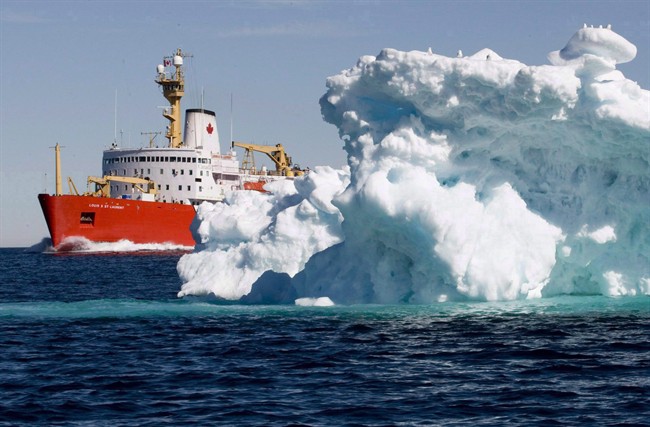A Canadian Coast Guard icebreaker has been called in to smash through pack ice off the northeast coast of New Brunswick in an unusual bid to help the critically endangered North Atlantic right whales expected to make their way to Canadian waters later this spring.

The goal is to allow local snow crab fishermen to complete their work in the Gulf of St. Lawrence earlier than usual, which should reduce the number of ship strikes and entanglements with fishing gear that killed so many whales last year.
READ MORE: Private companies set to help Canadian Coast Guard’s aging fleet with icebreaking
The federal government’s decision to move up the start date for the snow crab season in the Gulf was announced last month by Fisheries Minister Dominic LeBlanc, who also unveiled a series of other measures to save the lumbering mammals from extinction.
On Wednesday, the coast guard confirmed that the Sir William Alexander, a light icebreaker, had already helped clear ice from Shippagan harbour, on the north side of New Brunswick’s Acadian Peninsula.
However, spokesman Trevor Hodgson said the coast guard was keeping a close watch on a thick band of pack ice sitting outside the peninsula.
“It’s not something we can actually deal with using an icebreaker,” Hodgson told a news conference in St. John’s, N.L.
“We have to wait for Mother Nature to push that out of the area.”
With the wind direction expected to change by next week, the ice could soon be on its way out to sea, said Hodgson, the coast guard’s icebreaking superintendent for the Atlantic region.
But until that happens, it will be impossible to determine when the fishing season will open.
“The southwest winds are really what are going to drive the ice out of the region,” Hodgson said. “As long as that band is pressed against the fast ice (frozen in local harbours), there’s going to be a very limited breakup of that ice.”
WATCH: New measures introduced to protect right whales
Once the pack ice moves away, there are a number of other steps that must be taken to ensure a safe fishing season, he said.
While the icebreaker can handle thicker pack ice at depths of 10 metres or more, a coast guard hovercraft is typically used in April to clear the ice locked in the shallow harbours along the coastline. The machine, which sits on top of the ice, creates waves under the ice pack to break it up.
However, strong winds across the Gulf of St. Lawrence have prevented the hovercraft from leaving Trois-Rivieres, Que.
“Unfortunately, the weather is not looking great for this week,” Hodgson said.
As well, all of the ice must be cleared before the coast guard can deploy a required search and rescue vessel and navigational aids used by fishermen.









Comments